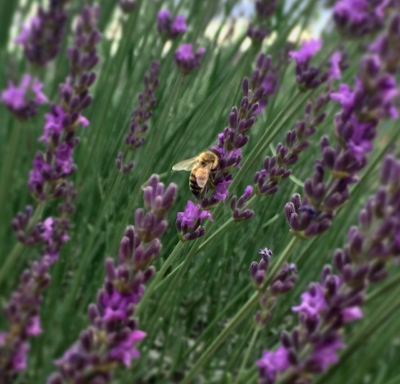LOW-WATER, HIGH-FASHION GARDENING
Alright, it is now officially hot. We’re feeling it, and our gardens are feeling it too! The long summers here are always a bit of a reminder that we should be savvy with our water use. Maybe you’re interested in lowering your water bill, but what if cacti just are not your look? Is it possible to have a low-water landscape that has all of the color, fullness, and ‘fluff’ of a high-water garden? We absolutely believe it is. So if you want to go for it, pick an area of your landscape in need of re-thinking, and clear it out for a fresh slate. Then, study up on some plants like these below and decide how to bring high fashion to your new low-water landscape!
CLASSIC FAVORITES
We forget that many classic garden plants are low-water when given the opportunity. The Marguerite daisy (to the right of the path in the title photo) seems to get by on nothing at all. It’s perfect for a casual border or sprinkled in with dry grasses where it will self-seed for a naturalized effect. Lavender is another classic favorite that thrives on very little. Other easily-forgotten companions are the many forms of Rosemary and Thyme, as well as Germander, Bearded Iris, many hybrids of Rose, Penstemon, Society Garlic, and Limonium (Sea Lavender, common in flower arrangements and wonderful in the garden.) More traditionally Xeric plants such as Yarrow and Catmint are spectacular when massed and mixed into combinations for full explosions of long-lasting color.
NEW FAVORITES
“Dry” doesn’t always mean boring! If you aren’t familiar with the plants below, you aren’t alone, since they are fairly new in garden popularity. They are beautiful, endlessly versatile, and have adapted over millennia to dry landscapes, like your new garden! Look these up and get ready to be impressed!
AS BACKGROUND AND FILL FOR LARGE AREAS:
Eriogonum giganteum – (St. Catherine’s Lace)
Phlomis russeliana – (Jerusalem Sage)
Romneya coulteri (Matilija Poppy)
Salvia uliginosa (Blue Spike Sage)
Verbena bonariensis (Canary Island Verbena)
AS CENTRAL COLOR:
Eriogonum umbellatum – (Sulphur Buckwheat)
Eriogonum grande var Rubescens– (Red-flowered Buckwheat)
Polygala fruticosa (Sweet Pea Shrub)
Phlomis cashmeriana – (Kashmir Sage)
Kniphofia varieties (Pokers – not just Red Hot anymore!)
AS LOW BORDERS AND GROUNDCOVERS:
Helianthemum varieties (Sunroses)
Teucrium cossonii (Creeping Germander)
DREAMY EFFECTS
So how do all of these plants come together? The charming full-sun landscape above is a great example of a full dry garden, with White Iceberg Roses, Salvia nemorosa ‘Rose Marvel’, and ephemerally floating Gaura lindheimeri for the look and feel of a traditional border with a fraction of the water use. These clients focused their water instead on their small lawn. It’s all about the balance! When it comes to these plant combinations, it’s all about color, texture and form. To get a similar effect to this garden with a different color scheme, try some of the plant combinations below, listed from tall (background) to short (foreground):
WARM PINK AND WHITE VARIATION

Rosa ‘Bonica’ or ‘Brilliant Pink Iceberg’
Salvia x ‘Shell Dancer’
Salvia nemorosa ‘White’
Sedum ‘Autumn Joy’
Cerastium tomentosum (Snow-in-Summer)
REGAL PURPLE AND GOLD VARIATION

Rosa ‘Rugelda’ or ‘Julia Child’
Allium sphaerocephalon (Round-headed Garlic)
Alstroemeria ‘Sussex Gold’
Salvia nemorosa ‘May Night’
Teucrium cossonii
For a taller effect, imagine the first variation with a background of St. Catherine’s Lace, or the second with the tall spikes of Jerusalem Sage. You can see how these gardens can be totally extravagant!
DRY SHADE
We did mention dry shade, didn’t we? One of the trickiest zones of a dry garden, many a gardener has been tempted to place a boulder in some gravel and call it a day. While we are all for the Zen garden look, there are some remarkable plants that will bring a full, ‘lush’ aesthetic to dry shade (plus, they look great among the boulders!) Take a look at:
Asparagus densiflorus myeri
Heuchera ‘Canyon Pink’ and ‘Santa Ana Cardinal’ (Coralbells)
Lamiastrum galeobdolon (Yellow Archangel)
(And check your local nursery for others!)
Remember that even a dry garden needs regular water to get established. We recommend having an irrigation system, even if it’s only seasonally used. Mulching is another great way to conserve soil moisture and cool roots. Roses especially will appreciate. Happy Gardening!
– The J. Montgomery Team
As always, we would love to hear how we can help you design your outdoor living space. Contact us anytime, we look forward to hearing from you!








